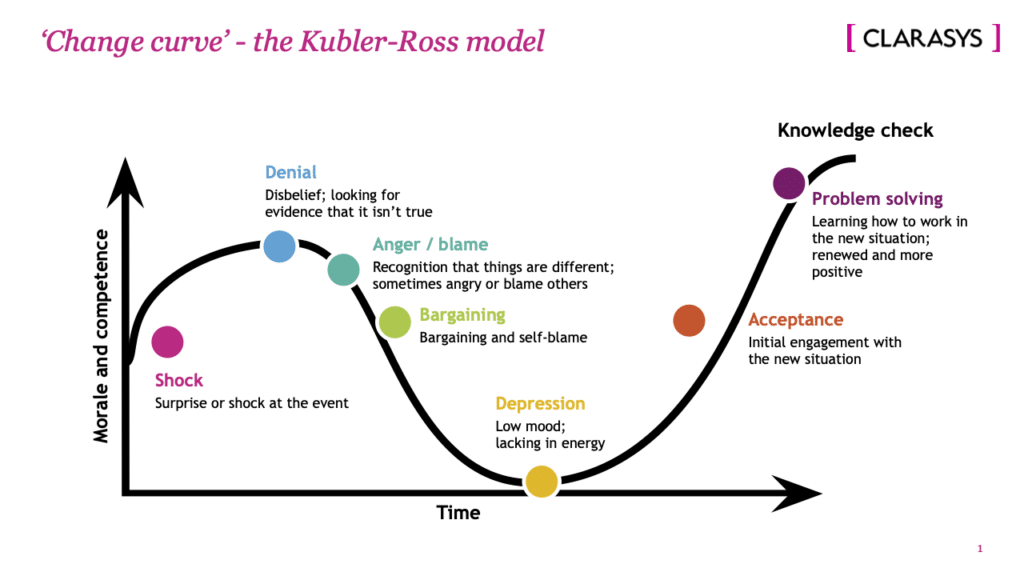Communicating change is important at every stage of a change project. Here we look at how the change team should communicate with the leadership team.
The art of communicating change in op model design – Part 1: The change team
The art of communicating change in op model design – Part 1: The change team
Communicating change is important at every stage of a change project. Here we look at how the change team should communicate with the leadership team.

Meet the author
The way that change is communicated to any team, whether it’s the change team speaking to the leadership team at the start of a project or leaders speaking to their people further down the line, plays a huge role in how we feel about the future of the business, our job security, and the journey ahead.
Therefore, it’s important at every stage of a change project, that communication is well thought out.
In this, the first of a three-part series about communicating change, we look at the job of the change team and how it should communicate with the leadership team. Leaders, whether they like the idea of change or not, need to buy in to the vision and start modelling desired behaviours early on. Because leaders can make or break a transformation, the change team must equip the leadership team with effective communication and ensure it is done thoughtfully and transparently.
Here are some key considerations that the change team should tailor to the organisation’s operating model change to make the desired impact.
Change team communicating change
At the start of a project, the change team’s job is to establish the current situation and decide on a tailored approach. Certain aspects of the transformation will need collaboration and input from leadership who will have more hands-on experience.
At this time, leaders will be asked questions by members of the wider team who know change is coming but are unsure of what it will look like. The change team’s role is to create an effective change plan detailing the approach that will be taken. The team also needs to design the comms with input from different sources (including leadership).
The change team will set the principles and create a roadmap of materials, content, and frequency, and establish the anticipated impact.
The change team must get buy-in from the leadership sponsor and then share the strategy with the wider leadership team, which will help them to handle things such as the emotional journey. Key initiatives as part of the change/comms plan will include how leadership manages fears and rumours, etc.
Communication provides reassurance
Communication reassures and sets the tone for how people feel and behave, and how they perceive the op model changes. The sooner the change team shares drips of communication, the better. The tone taken when introducing an op model programme really matters – it allows for a smooth, seamless transition, regardless of the size and impact of the change ahead. Always be transparent and if as a change team you don’t know the answer, be honest and say we will get back to you.
Reiterate the purpose of the programme and highlight the opportunities such as an improvement to customer or employee experience, increased productivity, or reduced stress.
Let people know that you understand how unnerving change can be, and show empathy for their response to change. Make a point of finding out how each member of the leadership team is reacting on the change curve (see below). This will ensure you have the tools in place to tackle the different scenarios that individuals will go through.
Communicating change through regular updates
Regular updates on progress are a priority when communicating change, particularly to the leadership team who are the “face of change”. Ensure there are channels available if and when queries arise. This can take the form of monthly programme business briefings designed to share any queries, concerns, or thoughts on the overall direction. Also, consider nominating a champion from the team to support the programme.
Keep people engaged by telling them what is coming next and how people can get involved. Remember, the change team will take people with them in their change mission if you are open to ideas rather than dictating the direction. By listening to and acting on the feedback you receive, the process will be more relatable and communication will be more personal.
Communicating change badly – the consequences
Good communication with leaders is crucial for the successful set-up of op model change. If communication about what the change will look like is poor and leaders cannot visualise the future state, they will be fearful and there will be a lack of trust. They are the role models in how others in the organisation will think, feel, and act about what is on the horizon. Therefore, how they handle the disruption could make or break the change. The change team should identify key individuals across the organisation to help represent the change to ensure communication is done well. These people will be your change champions. They need to model desired behaviours to the rest of the organisation. By helping leaders to become champions of change and great role models, the project will stand a better chance of success when it gets underway.
If you need help with people and change management please get in touch.


